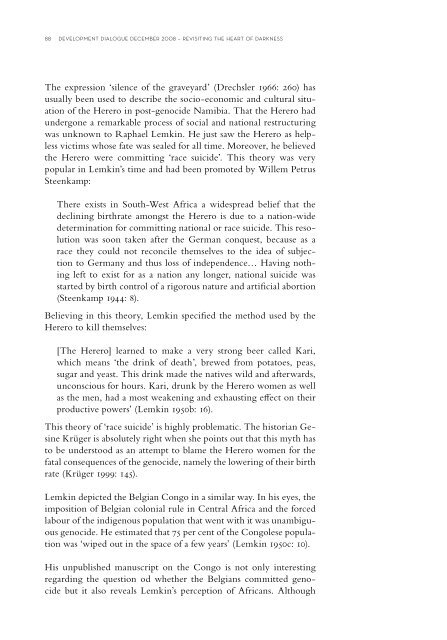60 years after the UN Convention - Dag Hammarskjöld Foundation
60 years after the UN Convention - Dag Hammarskjöld Foundation
60 years after the UN Convention - Dag Hammarskjöld Foundation
You also want an ePaper? Increase the reach of your titles
YUMPU automatically turns print PDFs into web optimized ePapers that Google loves.
88 development dialogue december 2008 – revisiting <strong>the</strong> heart of darkness<br />
The expression ‘silence of <strong>the</strong> graveyard’ (Drechsler 1966: 2<strong>60</strong>) has<br />
usually been used to describe <strong>the</strong> socio-economic and cultural situation<br />
of <strong>the</strong> Herero in post-genocide Namibia. That <strong>the</strong> Herero had<br />
undergone a remarkable process of social and national restructuring<br />
was unknown to Raphael Lemkin. He just saw <strong>the</strong> Herero as helpless<br />
victims whose fate was sealed for all time. Moreover, he believed<br />
<strong>the</strong> Herero were committing ‘race suicide’. This <strong>the</strong>ory was very<br />
popular in Lemkin’s time and had been promoted by Willem Petrus<br />
Steenkamp:<br />
There exists in South-West Africa a widespread belief that <strong>the</strong><br />
declining birthrate amongst <strong>the</strong> Herero is due to a nation-wide<br />
determination for committing national or race suicide. This resolution<br />
was soon taken <strong>after</strong> <strong>the</strong> German conquest, because as a<br />
race <strong>the</strong>y could not reconcile <strong>the</strong>mselves to <strong>the</strong> idea of subjection<br />
to Germany and thus loss of independence… Having nothing<br />
left to exist for as a nation any longer, national suicide was<br />
started by birth control of a rigorous nature and artifi cial abortion<br />
(Steenkamp 1944: 8).<br />
Believing in this <strong>the</strong>ory, Lemkin specifi ed <strong>the</strong> method used by <strong>the</strong><br />
Herero to kill <strong>the</strong>mselves:<br />
[The Herero] learned to make a very strong beer called Kari,<br />
which means ‘<strong>the</strong> drink of death’, brewed from potatoes, peas,<br />
sugar and yeast. This drink made <strong>the</strong> natives wild and <strong>after</strong>wards,<br />
unconscious for hours. Kari, drunk by <strong>the</strong> Herero women as well<br />
as <strong>the</strong> men, had a most weakening and exhausting eff ect on <strong>the</strong>ir<br />
productive powers’ (Lemkin 1950b: 16).<br />
This <strong>the</strong>ory of ‘race suicide’ is highly problematic. The historian Gesine<br />
Krüger is absolutely right when she points out that this myth has<br />
to be understood as an attempt to blame <strong>the</strong> Herero women for <strong>the</strong><br />
fatal consequences of <strong>the</strong> genocide, namely <strong>the</strong> lowering of <strong>the</strong>ir birth<br />
rate (Krüger 1999: 145).<br />
Lemkin depicted <strong>the</strong> Belgian Congo in a similar way. In his eyes, <strong>the</strong><br />
imposition of Belgian colonial rule in Central Africa and <strong>the</strong> forced<br />
labour of <strong>the</strong> indigenous population that went with it was unambiguous<br />
genocide. He estimated that 75 per cent of <strong>the</strong> Congolese population<br />
was ‘wiped out in <strong>the</strong> space of a few <strong>years</strong>’ (Lemkin 1950c: 10).<br />
His unpublished manuscript on <strong>the</strong> Congo is not only interesting<br />
regarding <strong>the</strong> question od whe<strong>the</strong>r <strong>the</strong> Belgians committed genocide<br />
but it also reveals Lemkin’s perception of Africans. Although

















